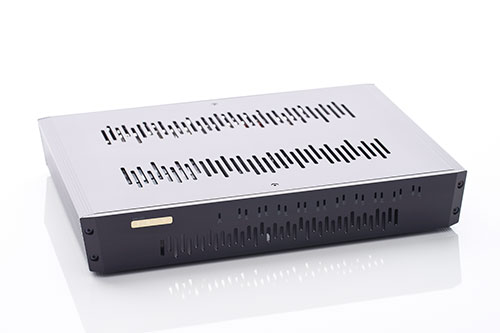The more complex Silence and Silence Plus stands are made in standard sizes of 45 by 36 or 50 by 44 centimetres. The stands are made of painted MDF and the THIXAR gel core, but they differ markedly in design and price. The Silence is normally painted black und with five M6 threads let into the bottom to accommodate three or four spikes. As such, it rests on the surface in a similar way to the Entrance model. The Silence has an enclosed MDF housing. Inside, it is filled with THIXAR gel. The spiked base unit is decoupled from the platform and the sides above it by means of an elastic joint. This is essential to ensure that no gel can leak out when deformed by heavy loads, instead retaining its shape as a damping core. With a thickness of 4.8 centimetres, not including spikes, the Silence is twice as tall as its little sister, the Entrance. The larger size of the Silence allows it to accommodate wide turntables or large amplifiers.

-
SOtM sNH-10G Netzwerk Switch
Wer hätte gedacht, dass meine Beschäftigung mit den SOtM-Geräten gleich zu einer Trilogie gerät. Aber dem Angebot von SOtM, auch noch den brandneuen Netzwerk Switch sNH-10G mit Clock-Modul in die Kette der SOtM-Geräte zu integrieren, konnte ich einfach nicht widerstehen. Beim Aufbau einer Streaming-Lösung wie mit dem Netzwerk-Player sMS-200ultra NEO kommt man ohne Netzwerkkomponenten nicht aus, wenn der Netzwerk-Player mit einem Medien-Server, auf dem sich die Musik befindet, verbunden werden soll. Hierzu nutzt man das…26.02.2019 -
finite elemente Cerabase compact & slimline, Cerapuc und Ceraball
Wenn es um die Frage der bestmöglichen Aufstellung für Audiokomponenten geht, scheiden sich die Geister. Doch egal ob im hochwertigen Rack oder auf dem Fußboden, wenn die Kette bereits auf hohem Niveau spielt, kann die passende Ankopplung das Hörerlebnis perfektionieren. Finite Elemente bietet zu diesem Zweck Füße in verschiedenen Ausführungen an. Im Vorwege des Tests habe ich ein ausführliches Telefonat mit Luis Fernandes von Finite Elemente geführt. Zwar war mir das den Spezialfüßen zugrundeliegende Prinzip…22.02.2019 -
AHP Klangmodule III G und IV G
Dieser Test war schon seit Jahren geplant, kommt aber dennoch gerade zur rechten Zeit: Denn während der diesjährigen High End hat AHP-Chef Andreas Jungblut das Klangmodul IV G vorgestellt, das dem III G klanglich überlegen sein soll – was ich nicht einfach so glauben muss, sondern auch hören kann. Es ist nun schon sechs Jahre her, dass ich die AHP-Feinsicherungen in fast allen Komponenten ausprobiert habe. Ich gebe gerne zu, dass ich vor Andreas Jungbluts…21.09.2018 -
Harmonix „The Base“ TB 0917 – The Music Platform
Selten habe ich einen Bericht mit so gemischten Gefühlen begonnen: Der Preis der Füße dürfte zu einer reflexartigen Verdammung des Test in einschlägigen Foren führen – von Autoren, die The Base wohl nie gehört haben. Andererseits haben mich Harmonix-Produkte nie enttäuscht: In diesem Falle wäre es nicht gut, sich an The Base zu gewöhnen, nur um sie bald zurückzuschicken. Was die nun schon bekannte, fast nicht existente Informationspolitik von Harmonix- und Hijiri-Entwickler Kiuchi-san und in…14.09.2018 -
PSI Audio AVAA C20 – Teil 2
Im ersten Teil habe ich die Technik der Bassfallen und ihre Wirkung in meinem großen Hörraum beschrieben. Da der Effekt von Maßnahmen zur Verbesserung der Akustik aber noch stärker von den aktuellen Gegebenheiten abhängig sein dürfte als der von Kabeln oder Netzfiltern, habe ich die AVAA auch noch in zwei weiteren Räumen ausprobiert. Nach den bisherigen Erfahrungen war ich sehr gespannt, wie sich zwei C20 in meinem Dachzimmer auswirken. Dies hat eine Grundfläche von etwa…03.08.2018 -
PSI Audio AVAA C20 – Teil 1
PSI Audio hat im professionellen Musik-Markt einen guten Namen.Unter Hifi-Freunden sind die interessanten Lautsprecher aus der Schweiz wenig bekannt. Ein ganz ungewöhnliches Produkt von PSI Audio ist die aktive Bassfalle AVAA C20. Auf der diesjährigen HighEnd begegnete mir PSI Audio erstmalig in der gemeinsamen Vorführung mit Weiss Engineering. Im Gespräch mit Daniel Weiss, dem Chef von Weiss Engineering Ltd, über die aktuelle Version seines vielseitigen DAC 502 Wandlers erwähnte er die Wirksamkeit des PSI Audio…30.07.2018
© 2025 | HIFISTATEMENT | netmagazine | Alle Rechte vorbehalten | Impressum | Datenschutz

























 |
|
































































































